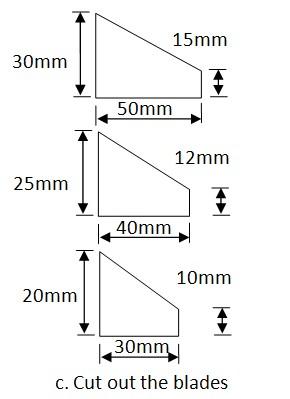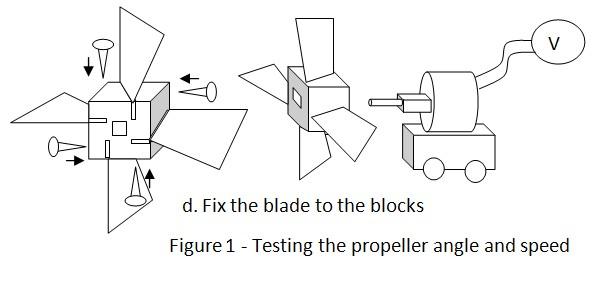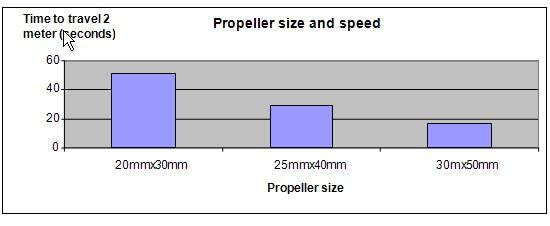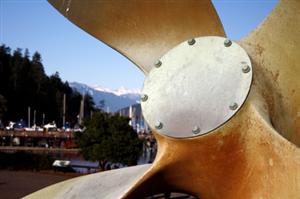| Complexity level: | 7 |
| Project cost ($): | 60 |
| Time required: | 1 day to prepare, 1 day for experiment |
| Material availability: | Easily found |
| Safety concerns: | Ensure the blades are properly fixed to the wooden block so that they do not come loose when they rotate. |
Hypothesis
Increasing the propeller size will produce a larger amount of thrust.
Overview
Propeller and thrust
Propellers are devices with blades that spin around like a fan. They are used to produce propulsion on boats and planes. The force produced by propellers can be explained by Bernoulli’s Principle and Newton’s 3rd Law of Motion. The rotational movement of the blades causes a displacement of air molecules that produces a forward motion called thrust.
A propeller is built with 2 or more blades that are attached to a central hub. The blades and the hub are connected to a shaft that extend from the engines. When an engine is started, the shaft turns, causing the blades and the hub to rotate. Blades have an aerofoil shape and when they turn, a difference in air or water pressure is created between the area in front and at the rear of the blades. This causes air or water to rush forward and thrust is produced.
A propeller’s forward thrust and speed can be improved by increasing the size of the blades, the rotational speed or blade angles. Increasing blade size and rotational speeds may not be possible due to mechanical constraints (eg. the blades hitting the hull or the onset of mechanical fatigue). The angle of the blade is normally varied along the blade’s length because each part of the blade travels at different speeds.
Scientific Terms
Materials
The materials required for this science fair project:
- A 12V dc motor
- 1 piece zinc sheet (thickness 0.5mm, size 750mm x 600mm)
- 1 pair of scissors
- 3 cubic wooden blocks measuring 20mm x 20mm x 20mm
- 1 electric hand drill and drill bits
- 1 set of needle file
- A protractor
- A sscrew driver and some screws
- A shoe box
- 4 toy car tires with 2 metal rods for support
- A DC12V battery
- A stopwatch
- A ruler
- Black masking tape
Procedure
1. For this science fair project, the independent variable is the size of the propeller blades. The dependent variable is the speed at which the boxes move as a result of the thrust that is generated by the propeller. This is measured by recording how long it takes for the shoe box to travel 2 meters. The constants (control variables) are the power of the motor, the angle of the blades, the size of the box and the distance covered by the box.
2. Using a hacksaw, slots at 20 degrees are cut into the sides of 3 wooden blocks. The propeller blades are then slotted in as shown in Figure 1. A hole is drilled in the center of the wooden block. The dimensions of the hole are modified with a needle file to ensure a good fit for the shaft of the propeller.
3. 4 holes are made at the bottom of the shoe box. 2 metal rods are inserted and 4 tires mounted. The masking tape is used to mark lines 2 meters apart for testing the speed of the box.
4. 4 blades are cut out according to the dimensions shown in Figure 1C. The blades are mounted onto the wooden block with screws. The motor is placed with the propeller onto the box. Secure them in place using duct tape. The DC12V battery is connected to the motor. The time taken by the boxes to move 2 meters is recorded and the results are shown in the table below.







Results
The results show that increasing the size of the propeller will make the box move faster.
The results show that increasing the size of the propeller will make the box move faster.
| Propeller size | 20mmx30mm | 25mmx40mm | 30mx50mm |
| Time to travel 2 meters (seconds) | 51 | 29 | 17 |
Use the graph below to plot the results of this science fair project.

Conclusion
The hypothesis that increasing the propeller size will make the box move faster, is proven correct.
Propellers are part of a propulsion system that is used in marine ships and aircrafts. The rotating propeller creates a pressure difference between the rear and front blades that causes water or air to move from high pressure to low pressure areas. This produces a thrustforce of thrust that results in the motion of the aircraft or ship. Despite advances in technology, the propeller, which was invented in the early 1800s, remains the most widely used form of propulsion system in marine transport.
Also consider
The science fair project can also be done by mounting the blades at different angles.
This experiment can also be repeated by changing the rotational speed of the motor.
Also consider - does the thickness of the propeller blade make a difference? What about the rigidity of the material used to make the propeller.
References
Propeller - http://en.wikipedia.org/wiki/Propeller
Aircraft propellers - http://www.thaitechnics.com/propeller/prop_intro.html

